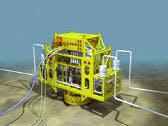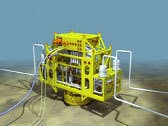The Spotlight on Technology at the 2006 Offshore Technology Conference recognized 13 recent innovations. The award program, started in 2004, highlights new technologies in offshore drilling and production.
OTC recognized:
• Aker Kvaerner ASA for MultiBooster, a subsea multiphase pump.
• Baker Oil Tools for Z-Seal, a metal-to-metal technology used in tubulars.
• Baker Oil Tools for its Smart Intervention System for taking various downhole measurements.
• CDS Engineering BV and FMC Kongsberg for their Tordis compact subsea separator with integrated solids handling.
• Draka Marine Oil & Gas International for Flex-Flame HC 1100/30 hydrocarbon fire-resistant cable.
• FMC Technologies Inc. for a subsea electric actuator system for manifold retrofit.
• Halliburton Co. for its Slimhole Reservoir Drilling and Evaluation System.
• PowerWell Services Inc. for the PowerAMPS managed-pressure drilling (MPD) system.
• ProPure AS (formerly CTour Process Systems AS) for the CTour process for extracting hydrocarbon contaminants from produced water.
• Schlumberger Ltd. for the EcoScope multifunction logging-while-drilling (LWD) service.
• Schlumberger Ltd. for its QuickSilver probe wireline sampling tool.
• V-Tech AS for UniTong, a multi- power tong. • Weatherford International Ltd. for its PowerStroke milling system.
To be selected, each technology had to:
1. Be less than 2 years old.
2. Be proven through full-scale application or successful prototype testing.
3. Have a broad interest and appeal for the industry.
4. Provide significant benefits beyond existing technologies.
Subsea production
Three awards went to components in subsea production.
Aker Kvaerner Subsea’s MultiBooster subsea multiphase pump, under development since 1998, aims to lower backpressure on the reservoir and increase flowline pressure to improve oil recovery and facilitate longer tie-back distances between subsea components and host facilities.
Aker Kvaerner says the twin-screw pump with a pressure-volume regulator operates efficiently in a gas void fraction (GVF) range of 0-95% and can maintain pressure up to 98% GVF. The company says the pump also operate at 100% GVF for a limited period, aiding start-ups and the need for priming the pump. The pump operates at speeds less than 2,000 rpm, reducing the risk of generating emulsions, and can handle very heavy and viscous fluids in excess of 1,000 cst, Aker Kvaerner says.
One booster pump is in operation in Lyell oil field off Scotland, and Aker Kvaerner says the Gulf of Mexico may see two pumps installed in 2007.
CDS Engineering and FMC Technologies have tested their Tordis compact cyclonic subsea separator with integrated solids handling on an offshore platform. The components will form an integral part of the subsea system in Statoil ASA’s 200,000 b/d Tordis field off Norway. The companies expect installation of the subsea components to start in mid-2006 with the subsea system becoming operational in 2007.
FMC Technologies says its electric actuator technology for subsea valves provides precise position control and can work without a hydraulic umbilical, providing a cost-saving potential.
The company based the system on local energy storage with rechargeable batteries that enable cost-efficient retrofitting for electrical operation of manual and hydraulically operated valves and chokes, such as in Statoil’s Norne oil and gas field in the Norwegian Sea. It says after the retrofit, Statoil will use the Norne field lines in the umbilical for chemical injection fluids so that the field will not require a new umbilical for new wells.
Downhole production
Two downhole technologies received awards.
Baker Oil Tools Z-Seal is a high-expansion, metal-to-metal sealing device that uses expanding metals in place of traditional elastomers to form a high-integrity pressure seal on the tubular wall. The company says the process makes well suspensions and interventions possible in hostile high-pressure and high-temperature completions.
Schlumberger’s QuickSilver probe wireline sampling tool aims to deliver a zero-filtrate-contaminated formation fluid sample. Schlumberger describes the tool as separating drilling mud filtrate at an early stage in the sampling process with the reservoir fluid (moving down the center of the tool) from the contaminated fluid (entering the perimeter of the probe). Both fluids remain isolated, and the process monitors in real-time the two pumping systems.
Safety, processing
Draka Marine Oil & Gas’s Flex-Flame HC 1100/30 hydrocarbon fire- resistant cable eliminates one potential weak link in the emergency system on offshore installation. The company describes its cable as passing the 1,100° C. test, with an energy of more than 200 kw/sq m. The company says the Flex-Flame wire and cables can maintain emergency power, emergency pumping systems, emergency seawater and fire pumping systems, and other critical applications in hazardous areas at temperatures above those that would melt copper conductor.
The Propure CTour process injects a solvent, such as condensate or NGL, into the water stream upstream of a hydrocyclone separator. Propure says the condensate, collected from the produced stream, extracts dissolved and dispersed hydrocarbon contaminants from the produced water.
Drilling awards
The Baker Oil Tools Smart Intervention System provides measurements of various parameters downhole, including weight on tool, torque, rpm, bending moment, vibration, and pressure. Information about the environment around the tools is transmitted to surface with mud-pulse telemetry and displayed on a rig-floor monitor.
Halliburton’s Sperry Drilling Services Slimhole Reservoir Drilling and Formation Evaluation system includes a 43⁄4-in. GeoTap slimhole formation pressure tester and the Geo-Pilot 5200 Series rotary steerable system. The Geo-Span downlinking system controls the tools.
The GeoTap tester is part of Sperry’s slimhole LWD package. The company says the tool provides formation pressure testing while drilling, eliminating the need for expensive pipe-conveyed wireline logging operations in high-angle wells. GeoTap can be used to conduct multiple tests at any point in the openhole interval with a multistage extending probe that has a snorkel feature to penetrate a filter cake.
Pressure data transmitted in real time can help verify the reservoir model and aid drilling decisions. The Geo-Pilot rotary steerable system is a point-the-bit slimhole system.
PowerAMPS automated managed pressure drilling system, developed by the Power Chokes division of PowerWell Services Inc., allows operators to drill more efficiently within narrow pressure environments. PowerAMPS says the system addresses many long-standing drilling and wellbore stability-related issues, including the elimination of pressure surges when stopping or starting circulation, improved drilling fluid management, enhanced equivalent circulating density (ECD) control, and improved hole conditions.
The PowerAMPS system, a continuous-circulation variation of MPD technology, predicts annular pressure profiles with a hydraulics well-modeling program that reads and processes data, including the drillstring rpm, rate of penetration, drilling-fluid viscosity, density, and temperature. The company says that after determining the desired pressure profile, PowerAMPS automatically modulates the choke, making microadjustments as necessary to compensate for changes in the annular friction pressure as annular flow rates increase or decrease.
Schlumberger’s EcoScope multifunction LWD service features pulsed-neutron technology, enabling simultaneous formation evaluation and drilling-related measurements without chemical sources such as americium-beryllium. The collected data help optimize drilling, formation evaluation, and well placement. The pulsed-neutron generator produces neutrons on demand, while the compact tool design includes a single, short collar that delivers a suite of drilling and formation evaluation measurements taken at the same depth and time.
The company says unique LWD measurements available with the EcoScope service include neutron-induced capture gamma-ray spectroscopy data, formation sigma as a salinity indicator, and neutron gamma density (a measure of gamma rays generated from neutron-formation interaction).
V-Tech AS says its UniTong is the world’s first multipower tong concentrically parked around the drillstring. The Unitong combines a spinner and torque tong in one unit, greatly improving rig-floor safety by reducing the machinery moving on a drill floor, according to the company. The pipe-dope facility is integrated and remotely operated, eliminating the need for rig hands to work with dope on the rig floor.
V-Tech says the tool can connect tubulars from 2 3/8-in. to 20-in. diameter, with three easily replaceable clamp elements. It can also handle power slips, slips segments, master bushings, and bottomhole assemblies. The torque-turn computer allows manipulation of delicate low-torque connections.
Weatherford says its PowerStroke milling system remediates subsidence-induced doglegs in a single run. Formation subsidence and shifting can cause severe deformation in wellbore casing. Mechanical failures created by extreme dogleg offsets over short distances can cause casing to shift so severely that production is restricted or lost.
The company says that milling damaged casing may avoid plugging and abandoning a well and also eliminate the need for drilling a replacement well.
A subsea multiphase pump system, called MultiBooster by developer Aker Kvaerner, received recognition at the OTC Spotlight on Technology.



